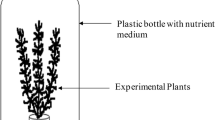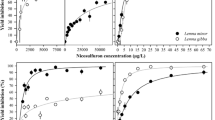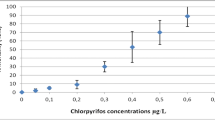Abstract
In its recent guidance document on tiered risk assessment for plant protection products for aquatic organisms, the European Food Safety Authority (EFSA) proposed to use Glyceria maxima as monocotyledonous grass species for the testing of special herbicide groups. However, published toxicity data for this species is very limited and there is no test guideline for Glyceria sp. For this reason a microcosm study was conducted in order to gain experience on the degree of sensitivity of G. maxima to the herbicidal substances clodinafop-propargyl (grass herbicide) and fluroxypyr (auxin) in comparison to the already established test organism water milfoil Myriophyllum spicatum and the duckweed species Landoltia punctata. Five concentrations without replicates were tested for each test substance using 10 microcosms and three microcosms served as controls. The experiment was run for 8 weeks. Morphological endpoints were used to determine growth and EC50 values. The results show that M. spicatum was most sensitive to fluroxypyr (37 days EC50 for roots: 62 µg/L) and G. maxima most sensitive to clodinafop-propargyl (22 days EC50 for total shoot length: 48 µg/L) whereas the duckweed species was considerable less sensitive. Hence, G. maxima turns out to be a good candidate for testing grass specific herbicides, supporting its inclusion as an additional macrophyte test for the risk assessment of herbicides as proposed by the EFSA.



Similar content being viewed by others
References
AMEG Report (2012) Myriophyllum Toxicity Test. Results of a ringtest using M. aquaticum and M. spicatum grown in a sediment-water test system. SETAC Aquatic Macrophyte Ecotoxicology Group (AMEG), final report (http://www.toxrat.de/index.php/70.html). Accessed 28 May 2014
Arts GHP, Belgers JDM, Hoekzema CH, Thissen JTNM (2008) Sensitivity of submersed freshwater macrophytes and endpoints in laboratory toxicity tests. Environ Pollut 153:199–206
Belkebir E, Rousselle C, Duboudin C, Bodin L, Bonvallot N (2011) Haber’s rule duration adjustments should not be used systematically for risk assessment in public health decision-making. Toxicol Lett 204:148–155
Berghahn R, Brandsch J, Piringer O, Pluta H-J, Winkler T (1999) On the suitability of fiberglass reinforced polyester as building material for mesocosms. Ecotox Environ Saf 43:267–273
Brock TCM, Lahr J, Van den Brink P (2000) Ecological risks of pesticides in freshwater ecosystems; Part 1: herbicides. Wageningen, Alterra
Caquet T, Lagadic L, Sheffield S (2000) Mesocosms in ecotoxicology (1): outdoor aquatic systems. Rev Environ Contam Toxicol 165:1–38
Cedergreen N, Streibig JC (2005) The toxicity of herbicides to non-target aquatic plants and algae: assessment of predictive factors and hazard. Pest Manag Sci 61:1152–1160
Coutris C, Merlina G, Silvestre J, Pinelli E, Elger A (2011) Can we predict community-wide effects of herbicides from toxicity tests on macrophyte species? Aquat Toxicol 101:49–56
Cuppen JGM, Van den Brink PJ, Van der Woude H, Zwaardemaker N, Brock TCM (1997) Sensitivity of macrophyte-dominated freshwater microcosms to chronic levels of the herbicide linuron. II. Community metabolism and invertebrates. Ecotox Environ Saf 38:25–35
Dabrowski JM, Schulz R (2003) Predicted and measured levels of azinphosmethyl in the Lourens River, South Africa: comparison of runoff and spray drift. Environ Toxicol Chem 22:494–500
Davies J, Honegger JL, Tencalla FG, Meregalli G, Brain P, Newman JR, Pitchford HF (2003) Herbicide risk assessment for non-target aquatic plants: sulfosulfuron—a case study. Pest Manage Sci 59:231–237
DIN EN ISO 11732 (2005) Wasserbeschaffenheit- Bestimmung von Ammoniumstickstoff- Verfahren mittels Fließanalytik (CFA und FIA) und spektrometrischer Detektion, Deutsche Fassung
DIN EN ISO 13395 (1996) Bestimmung von Nitritstickstoff, Nitratstickstoff und der Summe von beiden mit der Fließanalytik (CFA und FIA) und spektrometrischer Detektion, Deutsche Fassung
DIN EN ISO 15681-2 (2004) Wasserbeschaffenheit- Bestimmung von Ortophosphat und Gesamtphosphor mittels Fließanalytik (FIA und CFA); Teil 2: Verfahren mittels kontinuierlicher Durchflussanalyse (CFA), Deutsche Fassung
DIN EN ISO 16264 (2004) Wasserbeschaffenheit- Bestimmung löslicher Silicate mittels Fließanalytik (FIA und CFA) und photometrischer Detektion, Deutsche Fassung
DIN EN ISO 9963-1 (1995) Wasserbeschaffenheit- Bestimmung der Alkalinität, Teil 1: Bestimmung der gesamten und der zusammengesetzten Alkalinität, Deutsche Fassung
Ebert I, Bachmann J, Kühnen U, Küster A, Kussatz C, Maletzki D, Schlüter C (2011) Toxicity of the fluoroquinolone antibiotics enrofloxacin and ciprofloxacin to photoautotrophic aquatic organisms. Environ Toxicol Chem 30:2786–2792
EFSA (2013) European Food Safety Authority. Guidance on tiered risk assessment for plant protection products for aquatic organisms in edge-of-field surface waters. EFSA J 11:1–268
EPA (US Environmental Protection Agency) (1998) Fluroxypyr pesticide fact sheet. http://www.epa.gov/opp00001/chem_search/reg_actions/registration/fs_PC-128959_30-Sep-98.pdf. Accessed 28 May 2014
EPA (US Environmental Protection Agency) (2000) Clodinafop-propargyl pesticide fact sheet. http://www.epa.gov/opp00001/chem_search/reg_actions/registration/fs_PC-125203_06-Jun-00.pdf. Accessed 28 May 2014
FAO—Food and Agriculture organization of the United Nations (2006) FAO Specifications and evaluations for agricultural pesticides—Clodinafop-propargyl: http://www.fao.org/fileadmin/templates/agphome/documents/Pests_Pesticides/Specs/Clodinafop08.pdf. Accessed 28 May 2014
FOCUS (2006) Guidance document on estimating persistence and degradation kinetics from environmental fate studies on pesticides in EU registration”. Report of the FOCUS Work 91 Group on degradation kinetics, EC Document Reference Sanco/10058/2005 version 2.0
Guardo A, Williams R, Matthiessen P, Brooke D, Calamari D (1994) Simulation of pesticide runoff at Rosemaund Farm (UK) using the SoilFug model. Environ Sci Pollut Res 1:151–160
Heberer T (1995) Identifizierung und Quantifizierung von Pestizidrückständen und Umweltkontaminanten in Grund- und Oberflächenwassern mittels Kapillargaschromatographie- Massenspektrometrie. Wissenschaft & Technik Verlag, Berlin
Hock B, Fedtke C, Schmidt RR (1995) Herbizide—Entwicklung, Anwendung, Wirkungen, Nebenwirkungen. Georg Thieme Verlag, Stuttgart
Jager T (2014) Reconsidering sufficient and optimal test design in acute toxicity testing. Ecotoxicology 23:38–44
Knauer K, Vervliet-Scheebaum M, Dark RJ, Maund SJ (2006) Methods for assessing the toxicity of herbicides to submersed aquatic plants. Pest Manag Sci 62:715–722
Krausch G (1996) Farbatlas Wasser- und Uferpflanzen. Ulmer Verlag, Stuttgart
Kreuger J (1998) Pesticides in stream water within an agricultural catchment in southern Sweden, 1990–1996. Sci Total Environ 216:227–251
Lampert W, Sommer U (1999) Limnoökologie. Thieme, Stuttgart
Lewis MA (1995) Use of freshwater plants for phytotoxicity testing: a review. Environ Pollut 87:319–336
Liber K, Kaushik NK, Solomon KR, Carey JH (1992) Experimental designs for aquatic mesocosm studies: a comparison of the “ANOVA” and “Regression” design for assessing the impact of Tetrachlorphenol on zooplankton populations in limnocorrals. Environ Toxicol Chem 11:61–77
Liu F, O’Connell NV (2003) Simazine runoff from citrus orchards affected by shallow mechanical incorporation. J Environ Qual 32:78–83
Lüttge U, Kluge M, Bauer G (1997) Botanik. VCH Verlagsgesellschaft, Weinheim
Maltby L, Arts G, Heimbach F, Davies J, Pickl C, Poulsen V (2010) Aquatic macrophyte risk assessment for pesticides. CRC Press, Florida
Mohr S, Feibicke M, Ottenströer T, Meinecke S, Berghahn R, Schmidt R (2005) Enhanced experimental flexibility and control in ecotoxicological mesocosm experiments—A new outdoor and indoor pond and stream system. Environ Sci Pollut Res 12:5–7
Mohr S, Berghahn R, Feibicke M, Meinecke S, Ottenströer T, Schmiedling I, Schmiediche R, Schmidt R (2007) Effects of the herbicide metazachlor on macrophytes and ecosystem function in freshwater pond and stream mesocosms. Aquat Toxicol 82:73–84
Mohr S, Berghahn R, Mailahn W, Schmiediche R, Feibicke M, Schmidt R (2009) Toxic and accumulative potential of the antifouling biocide and TBT successor Irgarol on freshwater macrophytes: a pond mesocosm study. Environ Sci Technol 43:6838–6843
Mohr S, Schott J, Maletzki D, Hünken A (2013) Effects of toxicants with different modes of action on Myriophyllum spicatum in test systems with varying complexity. Ecotox Environ Saf 97:32–39
Neumann M, Schulz R, Schäfer K, Müller W, Mannheller W, Liess M (2002) The significance of entry routes as point and non-point sources of pesticides in small streams. Water Res 36:835–842
OECD (2006) Guidance document on simulated freshwater lentic field tests (outdoor microcosms and mesocosms). Environment health and safety publications series on testing and assessment, ENV/JM/MONO 17, Paris
PAN—Pesticide Action Network (PAN) Pesticides Database (2010a) Toxicity studies for fluroxypyr on aquatic plants: http://www.pesticideinfo.org/List_AquireAll.jsp?Rec_Id=PC36365&Taxa_Group=AquaticPlants. Accessed 28 May 2014
PAN—Pesticide Action Network (PAN) Pesticides Database (2010b) Toxicity studies for clodinafop-propargyl on aquatic plants: http://www.pesticideinfo.org/List_AquireAll.jsp?Rec_Id=PC38156&Taxa_Group=AquaticPlants. Accessed 28 May 2014
Schmidt R, Brockmeyer R (2002) Vorkommen und Verhalten von Expektorantien, Analgetika, Xylometazolin und deren Metaboliten in Gewässern und bei der Uferfiltration. Vom Wasser 98:37–54
Tomlin CDS (2009) The pesticide manual: a world compendium of pesticides, 15th edn. British Crop Protection Council, Alton
UBA Report (2011) Myriophyllum spicatum toxicity test: Results of an inter-laboratory ring test using a sediment-free test system. FKZ: 363 01 294; Final report. Federal Environment Agency, Division IV, Chemical and Biological Safety (http://www.oecd.org/env/ehs/testing/Report%20of%20ring%20test%20Myriophyllum-sediment-free_5%20March%202013.pdf). Accessed 28 May 2014
Vervliet-Scheebaum M, Knauer K, Maund SJ, Grade R, Wagner E (2006) Evaluating the necessity of additional aquatic plant testing by comparing the sensitivities of different species. Hydrobiologia 570:231–236
Vervliet-Scheebaum M, Straus A, Tremp H, Hamer M, Maund SJ, Wagner E, Schulz R (2010) A microcosm system to evaluate the toxicity of the triazine herbicide simazine on aquatic macrophytes. Environ Pollut 158:615–623
Wetzel RG (2001) Limnology. Lake and river ecosystems. Academic Press, San Diego
Wittmer I, Moschet C, Simovic J, Singer H, Stamm C, Hollender J (2014) Über 100 Pestizide in Fliessgewässern. Aqua and Gas 3:32–43
Acknowledgments
The authors would like to thank Miriam Langer, Karin Friede and the staff of the FSA for their practical support. Special thanks also to Stefan Loth and Ronny Schmiediche for their technical help. The analytical part of the department IV 2.5 is acknowledged for the chemical analysis. Jörn Wogram is thanked for his inspiring contributions to this project, and Ian Williams for the English spell check.
Conflict of interest
The authors declare that they have no conflict of interest.
Author information
Authors and Affiliations
Corresponding author
Rights and permissions
About this article
Cite this article
Mohr, S., Schott, J., Hoenemann, L. et al. Glyceria maxima as new test species for the EU risk assessment for herbicides: a microcosm study. Ecotoxicology 24, 309–320 (2015). https://doi.org/10.1007/s10646-014-1379-3
Accepted:
Published:
Issue Date:
DOI: https://doi.org/10.1007/s10646-014-1379-3




